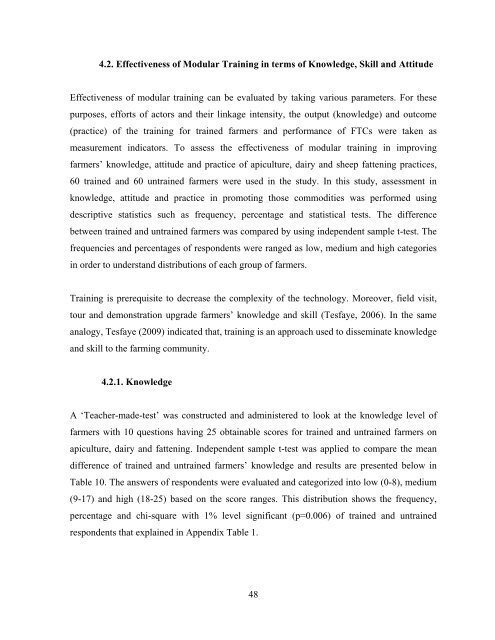effectiveness of modular training at farmers - IPMS Information ...
effectiveness of modular training at farmers - IPMS Information ...
effectiveness of modular training at farmers - IPMS Information ...
Create successful ePaper yourself
Turn your PDF publications into a flip-book with our unique Google optimized e-Paper software.
4.2. Effectiveness <strong>of</strong> Modular Training in terms <strong>of</strong> Knowledge, Skill and AttitudeEffectiveness <strong>of</strong> <strong>modular</strong> <strong>training</strong> can be evalu<strong>at</strong>ed by taking various parameters. For thesepurposes, efforts <strong>of</strong> actors and their linkage intensity, the output (knowledge) and outcome(practice) <strong>of</strong> the <strong>training</strong> for trained <strong>farmers</strong> and performance <strong>of</strong> FTCs were taken asmeasurement indic<strong>at</strong>ors. To assess the <strong>effectiveness</strong> <strong>of</strong> <strong>modular</strong> <strong>training</strong> in improving<strong>farmers</strong>’ knowledge, <strong>at</strong>titude and practice <strong>of</strong> apiculture, dairy and sheep f<strong>at</strong>tening practices,60 trained and 60 untrained <strong>farmers</strong> were used in the study. In this study, assessment inknowledge, <strong>at</strong>titude and practice in promoting those commodities was performed usingdescriptive st<strong>at</strong>istics such as frequency, percentage and st<strong>at</strong>istical tests. The differencebetween trained and untrained <strong>farmers</strong> was compared by using independent sample t-test. Thefrequencies and percentages <strong>of</strong> respondents were ranged as low, medium and high c<strong>at</strong>egoriesin order to understand distributions <strong>of</strong> each group <strong>of</strong> <strong>farmers</strong>.Training is prerequisite to decrease the complexity <strong>of</strong> the technology. Moreover, field visit,tour and demonstr<strong>at</strong>ion upgrade <strong>farmers</strong>’ knowledge and skill (Tesfaye, 2006). In the sameanalogy, Tesfaye (2009) indic<strong>at</strong>ed th<strong>at</strong>, <strong>training</strong> is an approach used to dissemin<strong>at</strong>e knowledgeand skill to the farming community.4.2.1. KnowledgeA ‘Teacher-made-test’ was constructed and administered to look <strong>at</strong> the knowledge level <strong>of</strong><strong>farmers</strong> with 10 questions having 25 obtainable scores for trained and untrained <strong>farmers</strong> onapiculture, dairy and f<strong>at</strong>tening. Independent sample t-test was applied to compare the meandifference <strong>of</strong> trained and untrained <strong>farmers</strong>’ knowledge and results are presented below inTable 10. The answers <strong>of</strong> respondents were evalu<strong>at</strong>ed and c<strong>at</strong>egorized into low (0-8), medium(9-17) and high (18-25) based on the score ranges. This distribution shows the frequency,percentage and chi-square with 1% level significant (p=0.006) <strong>of</strong> trained and untrainedrespondents th<strong>at</strong> explained in Appendix Table 1.48
















